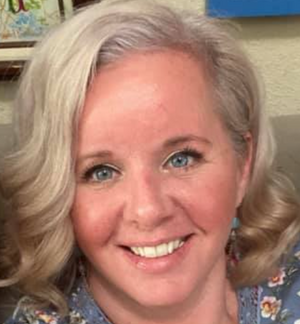My name's Christine McHone, and I'm a Senior Customer Success Manager at Slack.
In this article, I’ll explain how customer success at Slack has navigated the new normal of remote work in light of the global COVID pandemic.
I’ll share our journey from those early days of shelter in place to how we made the successful shift to remote work, emphasizing the importance of an empathy-first approach, and always keeping customer needs top of mind.
My new office and coworkers
As a result of this shift to remote work, I have a new office and some new co-workers. It's been eight months now since I've stepped foot in Slack headquarters, and I miss my colleagues.
But I've picked up a couple of new ones, my daughter, Sophia, who's six, and my son Aiden, who's four.
They really keep me on my toes while also being two of the best lunch companions. Before joining Slack, I occasionally worked from home and I also worked really hard at not giving the appearance of working from home.
If you've ever worked from home before shelter in place, I'm sure you can relate - the times, they're a bit different now.
The shift to remote
We're not only working from home, but we're doing so while simultaneously being caretakers or parents, or fur parents or school teachers, or while being completely isolated or a combination thereof.
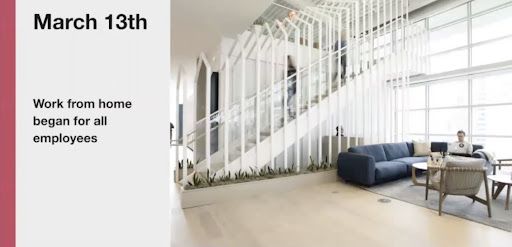
We're doing this in the midst of a worldwide pandemic.
Navigating the new norm
How do we navigate this new norm? How do we manage the realities of our world, while also being successful in our day-to-day working lives? It's empathy.

I mean, how can we really help our customers if we don't feel with them?
Day three
Starting off after shelter in place, I'll give you a little timeline, the first couple of days weren't too disruptive. By couple I mean the first two, this was day three.
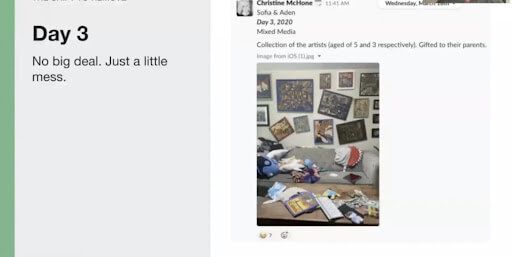
But during those early days, we updated our in-person meetings to video. We really stuck to the agenda and had our best work from home faces on.
But as the days wore on, and the return to work date kept getting pushed out further and further and further for all of us how we were communicating or maybe how we weren't communicating needed to adapt to our new realities.
We were scared and nervous and we were experiencing a lot of uncertainties. A lot of us had children at home. At one point, I was taking calls from the car just to avoid background noise and nobody was talking about it.
Day seven
So a couple of days after this picture was taken, we had a company all-hands meeting. It was a pivotal moment for me that occurred while attending this meeting. Our Chief Marketing Officer, Julie Legal was speaking when all of a sudden her two daughters climbed in her lap.
She just kept right on and didn't skip a beat. It was exactly what I needed to see and you could almost hear this collective sigh of relief from all the parents in the meeting.
I mean, this was our reality, live and on camera, front and center for the whole company to see. Then I began to embrace it.
I tore down the facade of a traditional work environment, the one that I constructed for the perceived benefit of my customers and colleagues.
Day eight
You can see here the next day, I usually kept my bedroom door shut and in this instance, my son busted through the door and jumped on the bed, and climbed on my shoulders.
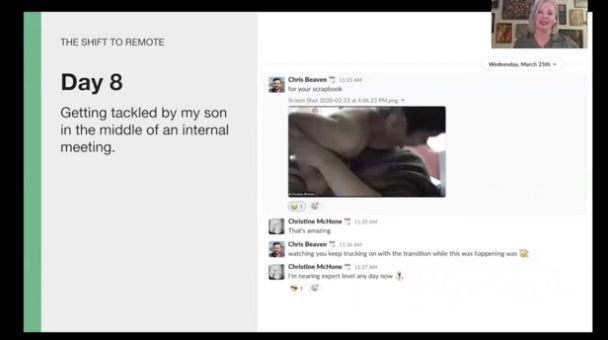
One of my colleagues captured that moment and I'm really glad that he did because it truly encompasses what those early days were like and it's funny looking back on it now.
Day ten
After this epiphany and tearing down this facade and realizing we should talk about this, I would start all my calls with, "How are you doing?" At first, maybe on the other side of the line, there was some hesitation.
But if they asked me, I'd respond honestly, "It's a circus here, I just had to cut slime out of my cat's fur before this call, because my son thought the cat needed a slime bath. And my daughter wouldn't attend class today until she was dressed up as Wednesday Adams. And I'm wearing pale powder right now and all black because she demanded that I dress up as Morticia. Other than that, not too bad".
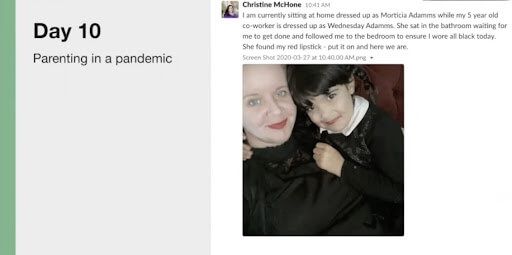
Just talking honestly and openly about our situation really paved a path for us to start being a little bit more empathetic and transparent with one another.
As I exposed my vulnerability, as I said, they would too. I wasn't asking how they were doing just for the sake of asking either. I truly wanted to know how they were doing.
I not only care about my customer success with Slack, but I really care about them as people too and it seemed completely disingenuous to avoid the elephant in the room.
Exposing my reality to customers and colleagues ultimately made us closer.
We laugh together, we worry together, we commiserate together. At the end of the day, we work hard for one another. And they know they can trust me because what you see is what you get.
Once you build that kind of trust, your relationship can only strengthen and become more transparent.
What is the shift to remote work?
It's, "Don't worry about it, I got it covered, let's sync up when you get back" or "I'll be running five minutes late while I get my son logged into his class".
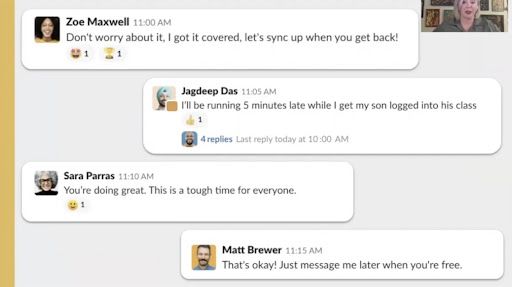
Or sometimes it's just words of encouragement, "You're doing great. This is a tough time for everyone" or "That's okay, just message me later when you're free".
But let's face it sometimes it's a bit of this.

It's occasionally covering your mouth while on mute to let your son know and not your co-workers know where the Lightning McQueen toy from Cars 1, not Cars 3 is.
Or to remind your daughter that it's time to log in to her learning A to Z activities in her Seesaw app, all while trying to be an active participant on that call.
It is what it is. We have new distractions. When we were in the office, it may have been someone coming up to our desk or maybe office visitors on a tour, a fire alarm, or an overwhelming need to hunt down some Sour Patch Kids in the cafe.
Things are a little different now and that's okay.
Okay it’s not exactly fine
It's not exactly fine but after that facade I was talking about was torn down I dove right into authentically sharing with my customers what we started to do internally to overcome some of the hurdles of remote work.
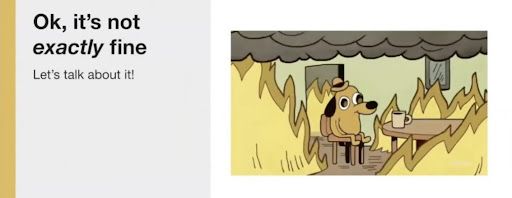
By bridging that topic early on, that everything is not fine, this conversation came naturally and was an authentic and compassionate outreach to see what Slack could do to help them navigate their new work environment.
Top of mind for customers
Internally, my colleagues and I were swapping stories in Slack to understand what was top of mind for our customers. We then created assets and provided recommendations to accommodate these new customer priorities.
A lot of what we heard at the beginning was how do we keep our employees engaged and happy during shelter in place? How do we replace watercooler discussions? And how do we ensure that employees are getting the support that they need?
It moved to how do we move meetings to Slack and how do we keep working?
Assets
We created a lot of assets to cover these topics, we've created webinars as well. We created initially one-page documents that covered topics such as how to get informed, how to get help, do work, take a break, how to get notified, and how to automate in Slack.
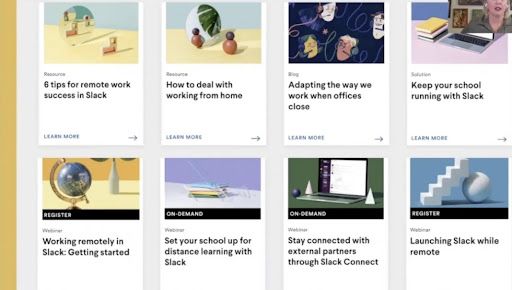
We made them really short and sweet to make them easy to digest, given all the issues at hand at that particular moment. I mean, we're all trying to just stay focused. So we wanted them to be really easy and simple lifts for our customers.
Best practices
Then we provided remote best practices in Slack and expanded those learnings as mentioned to include webinars that focused on remote work.
Office hours
We also held office hours with our customer experience team and during this time, we also had quite a few new customers logging into Slack for the first time.
Quick launch playbooks
So we created some quick launch playbooks to get them up and running as fast as possible. In one case, we were able to bring on 100,000 new Slack users in 72 hours, just for one customer.
Sharing in real-time
Not only would I share these assets with my customers, but I was also sharing everything we were doing internally at Slack, surrounding remote work in real-time.
We had sped up quite a few channels during this period, we had remote best practices, tales from work from home where we could post photos of how we were working from home, our setups, we had Zoom backgrounds, which was kind of fun.
We had remote work updates, so our leadership team could keep us informed of what was happening when we would be able to pick up things from the office.
One that I recently found was work-from-home fashion, which was kind of funny, and then social yelling, which is just a fun place to talk about our woes of the day in all caps.
To keep up with team camaraderie, we also held theme team meetings that we recommended to our customers too. Tiger King was really popular around this time so there were lots of tiger prints in these videos.
I would also recommend apps in our directory that could help bridge that virtual divide. Anything from digital whiteboarding apps to social apps that could serve as substitutes for those water cooler discussions we all miss so much. If you can think of it, there's most certainly an app for it.
Remote emoji pack
We also created a few feature updates aimed to delight our customers, including our remote emoji pack that visually encompasses our new reality.
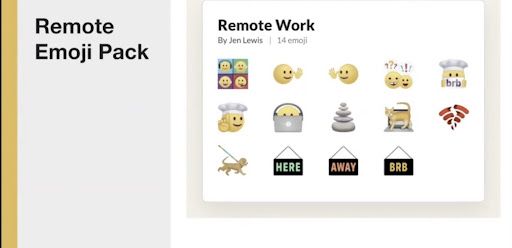
I use the cat walking on the laptop emoji quite a bit and the kid emoji has come in handy a few times in my status.
Workflow builder templates
We also created workflow builder templates that focused on keeping teams productive and connected by automating processes like daily huddles, and request approvals, and more.
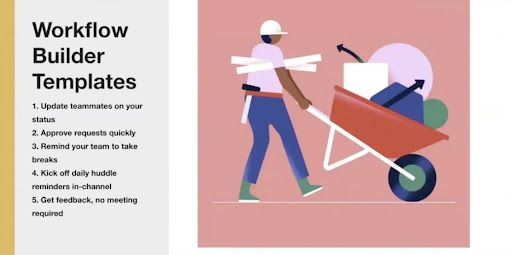
From desert sun to virtual space
We also had to move quite a number of our events to virtual. We used our experience of taking our big global sales event that was originally scheduled on March 13 fully virtual, we shared that with our customers that were thinking about canceling in-person events.
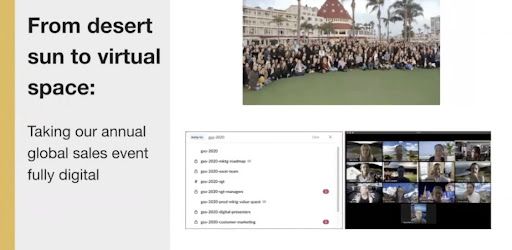
So we have a whole methodology now around hosting virtual events in Slack. The team that was able to put this together, was able to do so in 10 days. Moving it from Arizona to virtual.
There's also a blog post that talks about how we were able to accomplish this so check it out.
We still have ‘em
The one sad thing is we can't show up to customer visits with those Slack socks that everyone loves so much.
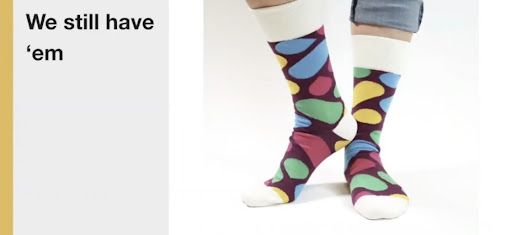
But what we do have now is redemption codes that we can share virtually with our customers so they can still keep their toes warm by having them delivered directly to their home offices.
How customers adapted via Slack
We've also learned a bunch of innovative Slack solutions that our customers have developed.
Virtual storytime
My favorite so far has been a virtual storytime that one of my customers’ hosts for their employees' children, executives all the way up to the CEO read stories to the kids and they make sure the sessions are offered across different time zones and age groups.
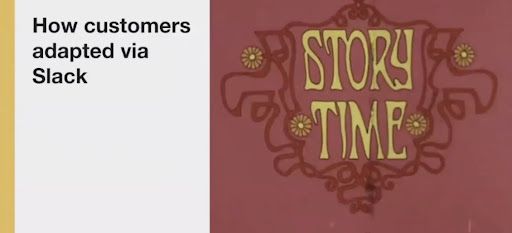
They arrange all of these sessions and organize them in Slack.
Embracing our new roles
Here we are eight and a half months later. What do we do now?
Embrace our new roles. My recommendation is to embrace these challenges, put them on display.
At the end of the day, we're all humans, and what better way to spend your working day than by being your authentic selves and by forging long-lasting friendships and partnerships with your customers and colleagues?
So as a stay-at-home full-time CSM, remote teacher's aide, Mama, being home with my babies is by far one of the best parts of my day too.
If you ever choose to check out my LinkedIn profile, I definitely updated it to include a role 'remote kindergarten teacher', but about a month ago, I downgraded myself to a 'teacher's aide' because I have a lot of late homework assignments getting turned in.
I would say, if you haven't done so in a while, I encourage you just to take a moment to check in with your customers. I'm sure it'll brighten their day.
Thank you.

